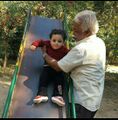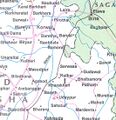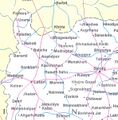Vidisha
| Author:Laxman Burdak IFS (R) |
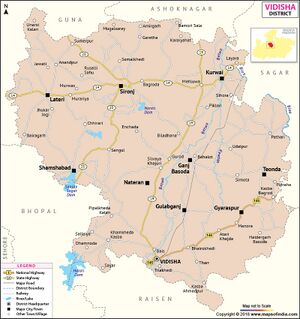
Vidisha (विदिशा) is a city and district in the central Indian state Madhya Pradesh, near its capital Bhopal. List of Mahabharata people and places includes Vidisha River (विदिशा) in Mahabharata (II.9.18), (II.9), (VI.10.27).
Variants of name
- Besnagar/Besanagara (बेसनगर) विदिशा, म.प्र., प्राचीन विदिशा (AS, p.645)
- Bhelsa
- Bhilsa (भीलसा)/(भिलसा), म.प्र., दे. Vidisha विदिशा, बेसनगर (AS, p.673)
- Vidisa
- Vedisagiri
- Vedisa
- Mahabalistana (महाबलिस्तान) (Alberuni) (AS, p.723)
- Vidishagiri (विदिशागिरि) (AS, p.857)
Location
Vidisha town is situated east of the Betwa River, in the fork of the Betwa and Bes Rivers, 10 km from Sanchi. The town of Besnagar, 3 km from present-day Vidisha on the west side of the river.
Sindh River originates on the Malwa Plateau in Vidisha district.
Jat Gotras
- Dhoreliaधोरेलिया
- Israwaइसरावा
- Khenwarखेनवार
- Porasपौरस
- Thenuaठेनुआ
- Sirohiसिरोही
- Chouhan चौहान
- Dondariyaदोंदरिया
- Palwarपालवार
- Budhotiyaबुधोतिया
- Kasinwarकासिनवार
- Punchhwarपूंछवार
- Hanseliaहंसेलिया
- Tomarतोमर
- Aghaअगा
- Sangwan सांगवान
- Chaharचाहर
- Bhagorभगोर
Tahsils in Vidisha district
- Basoda
- Gyaraspur
- Kurwai
- Lateri
- Nateran
- Sironj
- Vidisha
- Shamshabad
- Tyonda
- Gulabganj
- Pathari
- Vidisha Nagar
Villages in Vidisha tahsil
Abela, Adampur, Ahmada Nagar, Ahmadpur Tappa Kheda, Amachhawar, Amaukhedi, Amkheda Haweli, Amoda, Andiya Ahmadpur, Andiya Khurd, Arwariya, Badanpur, Bagri, Bais, Bala Barkheda, Ballakhedi, Baman Kheda, Bamankheda Lashkarpur, Bamora, Bamuriya, Bankhedi, Barkheda, Barkheda Ahmadpur, Barkheda Kachawa Padrat, Barkhedi Birma, Barkhedi Kasba, Barro, Beed Sarkar, Berkhedi Ahmadpur, Berkhedi Bujurg, Berkhedi Jetu, Bhadar Badagaon, Bhadora, Bhairokhedi, Bhatkhedi, Bhatni, Bhauriya, Bhila Khedi, Bhiya Khedi, Bhoot Parasi, Bilori, Boria Khamkheda, Byonchi, Chakpiya, Chhapkheda, Chhirkheda, Chidoriya Munjapta, Chidoriya Padrat, Chitoriya, Dabar, Dalla Khedi, Dangarwada, Deetakhedi, Dehri, Deo Khajuri, Deorajpur, Dhamnoda, Dhanora Haweli, Dharu Khedi, Dhaturiya Heweli, Dhol Khedi, Dulhai, Dupariya, Gadhla, Gajar, Gajikhedi, Gangarwada, Gehu Khedi, Ghatkhedi, Ghudiyakhedi, Goriya Khamkheda, Goriyakhamkheda, Gubarhela, Gurariya Haweli, Gurariya Lashkarpur, Hansua, Harukhedi, Hasnabad, Hinotiya, Hinotiya, Hirnai, Hirnoda, Ikodiya Lashkarpur, Imaliya, Imaliya Lashkarpur, Imaliya Parasi, Jafarkhedi, Jaitpura, Jalhari, Jamaldi, Jambar, Jhirniya, Jiwajipur, Kabula, Kachhi Kheda, Kachhwa, Kachnariya, Kaf, Kagpur, Kanari, Kankarkhedi, Karahi, Karaiya Hat, Karaiya Haweli, Karakhedi, Karariya Ahmadpur, Karariya Lashkarpur, Karela, Kariya Ahmadpur, Karodiya Bagoda, Kasba Ahmadpur, Katsara, Khai Kheda, Khajuri Thanner, Khamkheda Kasba, Khamkheda Lashkarpur, Khammukhedi, Khamtala, Khaparkheda, Khari, Kharwai, Khejada Ahmadpur, Khejada Sultan, Kherua Lashkarpur, Khiriya, Kirimchi Bandhera, Kolinja, Kothichar Kalan, Kothichar Khurd, Kotra Lashkarpur, Kuwakhedi, Lala Khedi, Lashkarpur, Lodha Khedi, Madankhedi, Madhiya Kalan, Madhiya Khurd, Mahuakheda (Khamkheda), Meharkhedi Padrat, Mirzapur, Mudra Ahmadpur, Mudra Durjansal, Mudra Surai, Muhana, Mundra Abela, Mundra Harisingh, Mungod, Murwara, Namakhedi, Narot, Nathanpur, Neemkheda, Nimkhiriya, Nitarri, Padrayat, Padriya, Padriya Mafi, Paho(Kohakhedi), Palki, Paloh, Panjh, Paras, Parasi Gujar, Parasi Khurd, Parasi Tunda, Pardhi, Parsora, Parsora Haweli, Parsukhedi, Pathrai Haweli, Pathriya, Perwara, Pipal Hutha, Pipalkheda Kalan, Pipalkheda Khurd, Pipariya Ajit, Pipariya Mota, Pipariya Nag, Pipriyaghat, Porukhedi, Powa Nala, Purenia, Ramgarh, Rampur Bandhiya, Rampura, Rangai, Roda, Rusalli Khamkheda, Ruslla, Sagoda, Salaikhedi, Sallaiya, Samrasukha, San, Sangai, Sangakhedi, Sankalkheda Kalan, Sankalkheda Khurd, Sanoti, Satiyakhedi, Satpada Ahmadpur, Satpadakalan, Sayar, Semra Ahamadpur, Semra Lashkarpur, Shajakhedi, Sherpurkasba, Silpari, Sonthar, Sorai, Sothiya, Suakhedi, Sugnakhedi, Sultaniya, Sunpura, Surod, Thanner, Tharr, Tigra, Tilak, Tilakhedi, Tori, Udaigiri, Udlakhedi, Vidisha, (M) Vighan,
History
The town is situated east of the Betwa River, in the fork of the Betwa and Bes rivers, 10 km from Sanchi. The town of Besnagar, 3 km from present-day Vidisha on the west side of the river, became an important trade center in the sixth and fifth centuries BCE, under the Sungas, Nagas, Satavahanas, and Guptas, and was mentioned in the Pali scriptures. The Emperor Ashoka was the governor of Vidisha and it finds mention in Kalidasa's immortal Meghdoot. Besnagar was abandoned in the sixth century, it came into prominence again as Bhelsa during the medieval period. It thus, passed on to the Malwa Sultans, the Mughals and the Scindias.
K.P. Jayaswal attributes Bagat, a village in the Jhansi district as the home of Vakatakas. But after refuting the theory regarding the northern home of the Vakatakas, V.V. Mirashi points out that the earliest mention of the name Vakataka occurs in an inscription found on a fragment of a pillar at Amravati which records the gift of a Grihapati (householder) Vakataka and his two wives. This Grihapati in all probability was the progenitor of Vidhyashakti. It appears from the Puranas that Vindhyasakti was a ruler of Vidisha (in the present day Madhya Pradesh state) but that is not considered to be correct.[1]
During 3-4th centuries AD Nagas became powerful in Central India. The Nagas had their main centres at Kantipuri (modern Kutwar, Morena district), Padmavati (Pawaya, near Gwalior) and Vidisa. The coins of the Nagas have been discovered in thousands from these places and preserved at Gwalior Museum.[2]
Dilip Kumar Ganguly[3] writes that ....The Nagas established their rule at Vidisha, Padmavati (modern Padam Pawaya, Mathura and Kantipura, which has been identified by KP Jayaswal as Kantit between Mirzapur and Vindhyachal, but located more properly at Kutwal or Kutwar in Morena district Madhya Pradesh.
Dr Naval Viyogi[4] writes that Sometimes before Samudragupta, (335-375 AD) the Naga kings were ruling over Eran. As,[5] Padmavati, Kantipuri and Mathura were three centres of their rule, the Eran- Vidisa was fourth. Naga coins have been recovered in a very large number from this region. All these four kingdoms were inter-related with each other and perhaps, they all unitedly encountered the attacks of Kushanas and Scythians and pushed them back from their motherland.
The ruins of a Hindu shrine at Vidisha dedicated to Vishnu reveal that the foundation bricks were cemented together with lime mortar, the first known example of the use of cement in India. The ruins are of period prior to 2nd century BC.
Close to the ruins are the remains of votive pillars with palm-leaf capitals; the only one that still stands is the Heliodorus pillar, also known as Khamba Baba. A monolithic free-standing column, the pillar bears an inscription which states that it was Garuda Pillar, raised in honour of Vasudeva by Heliodorous, a resident of Taxila, who had been sent to the court of Bhagabhadra as an envoy of Indo-Greek monarch, Antialkidas. This inscription is a valuable historical record, revealing both the relations that existed between the region and the Greek kingdoms of the Punjab, and the fact that the Greek ambassador had become a follower of Hindu god Vishnu. The inclusion of the name of Antialkidas dates the erection of the pillar to approximately 140 BC.
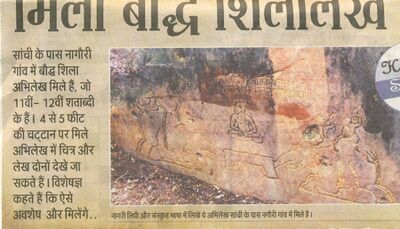
Recently Inscription of Buddha have been discovered at village Nagaur Vidisha in Nateran tahsil in Vidisha district of Madhya Pradesh. This Inscription is of 11-12th century and engraved on a rocks of 4-5 feet high. The Inscription is in pictorial form as well as in sanskrit language with nagari script. The archaeologists are of the view that there must some more inscription like this. There is a need to further research.
The Naga coins found at Eran, Vidisha, Pawaya (Padmabati), and Mathura show various common features the names of rulers occurring on these coins are to be carefully studied and compared in order to arrive at a correct attribution and chronology of the Nagas.[6] The mints at Eran and Vidisha produced a large number of copper coins. Copper was available in large quantities in the Balaghat area for the mints at Eran, Vidisha attesting to the great importance of this town as a political seat and also as a mint-town.
Sabha Parva, Mahabharata/Book II Chapter 47 mentions Kings who brought tributes to Yudhishthira. Karpasika tribe is mentioned in Mahabharata (II.47.7)[7], which states ...Hundred thousands of serving girls of the Karpasika country, all of beautiful features and slender waist and luxuriant hair and decked in golden ornaments .... were brought as tribute unto king Yudhishthira.
Sandhya Jain[8] writes that Karpasika (कार्पासिक) tribe who Brought tributes to Yudhisthira; possibly hailed from the Vidisha region in Central India.
बेसनगर
विजयेन्द्र कुमार माथुर[9] ने लेख किया है ...बेसनगर, विदिशा, म.प्र., (AS, p.645): यह प्राचीन विदिशा और पाली ग्रंथों का बेस्सनगर है। यह कस्बा भीलसा से 2 मील पश्चिम की ओर प्राचीन विदिशा के स्थान पर बसा हुआ है। यहां के खंडहरों में से अनेक प्राचीन महत्वपूर्ण अवशेष प्राप्त हुए हैं। इनमें हिलिओडोरस का स्तंभ, जिसे स्थानीय लोग खंभबाबा कहते हैं, मुख्य है। इस पर अंकित अभिलेख (लगभग 130 ईसा पूर्व) से सूचित होता है कि इसे हिलिओडोरस नामक ग्रीक में भगवान वासुदेव (कृष्ण) के स्मारक के रूप में बनवाया था। यह यवन, तक्षशिला के भागवत (हिंदू) यवनराज अंतियालसिडस (Antialcides) का राजदूत था जिसे विदिशा के महाराज भागभद्र की राजसभा में भेजा गया था। इस स्तंभ-लेख से बौद्ध धर्म की अवनति के साथ-साथ हिंदू या भागवत धर्म की बढ़ती हुई शक्ति का जिसने स्वसभ्यताभिमानी ग्रीकों को भी अपने प्रभाव में आबद्ध कर लिया था, सुंदर परिचय मिलता है।
बेसनगर परिचय
बेसनगर पूर्वी मालवा में स्थित प्राचीन नगर विदिशा का ही आधुनिक नाम है। शुंग राजाओं के शासन काल में इस नगर का बहुत ही महत्त्व था। शुंग राजाओं के शासन के बाद भी अनेक वर्षों तक बेसनगर स्थानीय शासकों की राजधानी बना रहा। यहाँ के शासकों ने भारत की पश्चिमोत्तर सीमा पर स्थित यवन शासकों के साथ राजनीतिक सम्बन्ध बना रखे थे। बेसनगर में भगवान वासुदेव के सम्मान में तक्षशिला के राजा एंटिआल्किडस के राजदूत हेलियोडोरस ने (लगभग 135 ई. पू.) में एक 'गरुड़ ध्वज' स्थापित कराया गया था।
इतिहास: बेसनगर को पाली बौद्ध ग्रंथों में 'वेस्सागर' तथा संस्कृत साहित्य में विदिशा के नाम से पुकारा गया है। भिलसा रेलवे स्टेशन से पश्चिम की तरफ़ क़रीब 2 मील (लगभग 3.2 कि.मी.) की दूरी पर स्थित यह स्थान पुरातत्वेत्ताओं की सांस्कृतिक भूमि कहा जा सकता है। यह वेत्रवती और बेस नदी से घिरा हुआ है तथा शेष दो तरफ़ की भूमि पर प्राचीर बनाकर नगर को एक क़िले का रूप प्रदान कर दिया गया था।
अवशेष: प्राचीन काल का वैभव संपन्न यह नगर अब टूटी-फूटी मूर्तियों व कलायुक्त भवनों का खंडहर मात्र रह गया है। यहाँ पाये जाने वाले भग्नावशेष ईसा पूर्व तीसरी शताब्दी से 11वीं शताब्दी तक की कहानी कहते हैं। अब भी इस स्थान पर ही एक तरफ़ बेस नामक ग्राम बचा हुआ है। बेसनगर का राजनीतिक महत्व मौर्य काल में अशोक के समय से बढ़ा। शुंग काल में यह बहुत ही प्रसिद्ध धार्मिक केंद्र के रूप में दूर-दूर तक जाना जाता था। यह स्थान हिन्दू व बौद्ध दोनों के लिए ही महत्त्वपूर्ण था। गुप्त काल तक इसकी समृद्धि क़ायम रही। उसके पश्चात् इसके कृत्रिम इतिहास का स्पष्ट साक्ष्य नहीं मिलता।
उत्खनन कार्य: 10वीं शताब्दी में नदी के दूसरी तरफ़ स्थित 'भिलसा' अस्तित्व में आ चुका था। बेसनगर के ऐतिहासिक महत्व को देखते हुए पुरातत्व विभाग द्वारा उत्खनन कार्य किये गये थे। उत्खनन में मिले कुछ अवशेष ईसवी काल के प्रारंभ के सामाजिक जीवन पर प्रकाश डालते हैं। पुराणों के अनुसार यहाँ पुष्यमित्र शुंग ने यज्ञ किया था। खुदाई में बड़े-बड़े यज्ञों की कार्यस्थली के विशेष चिह्न मिले हैं। विद्धानों द्वारा शास्त्रार्थ किये जाने वाले कक्ष एवं भोजनशाला का प्रमाण भी मिलता है। इसके अलावा विभिन्न कार्यों से संबद्ध कई तरह की मुद्राएँ तथा मिट्टी की पकाई हुई वस्तुओं से उनके जीवन की झांकी प्रतिबिंबित होती है।
कई साहित्यिक तथा पुरातात्विक प्रमाण इस स्थान का यवनों से संबंध स्पष्ट करते हैं। अभिलेखों में मिले शब्द 'द्विमित्रिय' को सिकंदर कालीन यूनानी शासक के रूप में माना जाता है। खाम बाबा का निर्माण भी यवन राजदूत अंकलितस ने ही करवाया था। यह कहा जाता है कि वर्तमान दुर्जनपुरा वही स्थान है, जहाँ यवनों का वास हुआ करता है। पहले यह दुमितपुरा के नाम से जाना जाता था।
संदर्भ: भारतकोश-बेसनगर
भीलसा
Bhilsa भीलसा, म.प्र., (AS, p.673)- भीलसा का नाम संभवत: भैल्लस्वामिन् के सूर्य-मंदिर के नाम के साथ संबंधित है. 11वीं शती में अलबेरूनी ने इस स्थान को महाबलिस्तान लिखा था. यह स्थान प्राचीन नगरी विदिशा के निकट था. (दे. विदिशा, बेसनगर)[10]
भिलसा प्राचीन नगर विदिशा का आधुनिक नाम है। इसके निकट कुछ प्राचीन स्तूपों के अवशेष प्राप्त हुए हैं। जनश्रुतियों के अनुसार इन स्तूपों को सम्राट अशोक द्वारा स्थापित बताया जाता है। मुसलमानों के समय में यह फलता-फूलता नगर था। यहाँ पर एक क़िला भी था, जिससे मालवा प्रदेश में भिलसा सामरिक महत्व का स्थान माना जाता था। भिलसा पर सुल्तान इल्तुतमिश ने 1234 ई. में अपना अधिकार कर लिया था। इसके पश्चात् 1292 ई. में इस पर अलाउद्दीन ख़िलजी का क़ब्ज़ा हो गया। इसके फलस्वरूप अलाउद्दीन के लिए दक्षिण भारत पर चढ़ाई करने का मार्ग प्रशस्त हो गया।[11]
विदिशा
विजयेन्द्र कुमार माथुर[12] ने लेख किया है .....1. विदिशा (AS, p.855) प्राचीन भारत की प्रसिद्ध नगरी थी, जिसका अभिज्ञान वर्तमान भीलसा या बेसनगर से किया गया है। यह नगरी वेत्रवती नदी (= बेतवा) के तट पर बसी हुई थी।
विदिशा का शायद सर्वप्रथम उल्लेख वाल्मीकि रामायण[13]में है, जिससे सूचित होता है कि शत्रुघ्न के पुत्र शत्रुघाती को विदिशा और सुबाहु को मधुरा या मथुरा का राजा बनाया गया था- ‘सुबाहुर्मघुरा लेभे, शत्रुघाती च वैदिशम्’।
कालिदास ने भी इस तथ्य का उल्लेख 'रघुवंश'(रघुवंश 15,36)में किया है- 'शत्रुघातिनि शत्रुघ्नः, सुबाहौ च बहुश्रुते मधुरा विदिशे सून्वों निर्दधे पूर्वोत्सुकः’।
अशोक के समय में विदिशा दक्षिण पथ की मुख्य नगरी थी। अपने पिता के शासन काल में अशोक दक्षिणा पथ का शासक था और विदिशा में ही रहता था। यहीं के एक धनवान् श्रेष्ठी की कन्या देवी से उसने विवाह किया था। बौद्ध साहित्य से सूचित होता है कि अशोक के पुत्र और पुत्री- महेन्द्र और संघमित्रा, देवी ही की संतान थे। (दे. महावंश, 13,7) ‘फिर धीरे-धीरे महेन्द्र (अशोक का पुत्र स्थविर महेंद्र) ने विदिशा नगर में पहुंच कर अपनी माता देवी के दर्शन किए और उन्हें विदिशा गिरि विहार में उतारा’। (यहां विदिशागिरि से सांची की पहाड़ी निर्दिष्ट जान पड़ती है।) अशोक ने मगध सम्राट बनने के पश्चात् विदिशा के उपनगर सांची में अपना प्रसिद्ध स्तूप बनवाया था। इसके तोरण शुंग काल में बने थे। पुष्यमित्र शुंग जिस समय मगध का सम्राट था (द्वितीय शती ई. पू.), तब विदिशा में उसका पुत्र अग्निमित्र शासक के रूप में रहता था।
कालिदास ने 'मालविकाग्निमित्र' नाटक में विदिशा को अग्निमित्र की राजधानी माना है- ‘स्वस्ति। यज्ञशरणात्सेनापतिः पुष्यमित्रों वैदिशस्थं पुत्रमायुष्मन्तमग्निमित्रं स्नेहात्परिष्वज्येदमनुदर्शयति’। (अंक 5) विदिशा उस समय समृद्धशालिनी नगरी थी तथा यहाँ व्यापारिक सार्थ निरंतर आते-जाते रहते थे- ‘इमांतथागत भ्रातृकां मया सार्धमपवाह्म भवत् संबंधापेक्षया पथिकसार्थ विदिशागामिनमनु प्रविष्ट’। (वहीं, अंक 5)
विदिशा का दशार्ण की राजधानी के रूप में उल्लेख तथा उसके निकट बहने वाली नदी वेत्रवती का सुंदर वर्णन कालिदास ने 'मेघदूत' (पूर्व मेघ 26) में इस प्रकार किया है- 'तेषां दिक्षु प्रथितविदिशालक्षणां राजधानीम् गत्वा सद्यः फलमतिमहत कामुकत्वस्य लब्ध्वा, तीरोपरान्तस्तनिक सुभगं पास्यसि स्वादुयुक्तम्, सभ्रूभंग मुखमिव पयो वेत्रवत्याश्चलोमिः’।
इस वर्णन से इस बात का प्रमाण मिलता है कि कालिदास के समय तक (संभवतः 5वीं शती ई. का पूर्व भाग) विदिशा ‘प्रथित’ अथवा प्रसिद्ध नगरी थी। महाकवि बाणभट्ट (7वीं शती ई. तक) ने 'कादंबरी' के प्रारंभ में ही अपनी कथा के पात्र राजा शूद्रक की राजधानी विदिशा में वेत्रवती के तट पर बताई है- ‘वेत्रवत्या सरिता परिगतविदिशाभिधाना नगरी राजधान्यासीत्’।
विष्णुपुराण 3,64 में भी विदिशा का नामोल्लेख है- 'विदिशाख्यं पुरं गत्वा तदवस्थ ददर्शतम्’।
[p.857]: गुप्त युग के पश्चात् काफी समय तक विदिशा का इतिहास तिमिराच्छन रहा। 11वीं शती में अलबेरूनी ने विदिशा या भीलसा का नाम महाबलिस्तान बताया है। मध्य युग में विदिशा के बहुत दिनों तक मालवा के सुल्तानों के शासनाधीन रहने के प्रमाण मिलते हैं। मुग़ल काल में विदिशा (भीलसा) मालवा के सूबे की छोटी सी नगरी मात्र थी। धर्माध औरंगज़ेब ने इस प्राचीन नगरी का नाम बदलकर आलमगीरपुर रखा था, जो कभी प्रचलित न हुआ।
18वीं शती में विदिशा में मराठों का राज्य स्थापित हो गया और तब से आधुनिक काल तक यह भूतपूर्व ग्वालियर रियासत की एक छोटी किंतु महत्वपूर्ण नगरी बनी रही। विदिशा के अनेक प्राचीन स्मारकों में विजयामंडल या बीजमंडल नामक मसजिद भी है, जो 11वीं शती के लगभग बने चर्चिका या विजयादेवी के मंदिर को तोड़कर उसी के मसाले से बनवाई गई थी। इसका प्रमाण मसजिद के एक स्तंभ पर उत्कीर्ण संस्कृत लेख से मिलता है। बेसनगर (पाली बेस्सनगर) विदिशा की प्राचीन मुख्य नगरी का ही एक भाग था और भीलसा इस नगरी के मध्ययुगीन संस्करण का नाम है।
2. विदिशा नदी (AS, p.857): विदिशा नामक नदी का उल्लेख महाभारत सभा पर्व महाभारत 9,18 में किया गया है-'कालिंदी विदिशा वेणा नर्मदा वेगवाहिनी'। निश्चय रूप से यह विदिशा या वर्तमान बेसनगर के पास बहने वाली बेस नदी का ही नाम है ।[14]
विदिशागिरि
विदिशागिरि (AS, p.857) - यह महावंश 13 में उल्लिखित है. विदिशागिरि या तो विदिशा नगरी ही है या उसके पास की सांची पहाड़ी.[15]
महाबलिस्तान
महाबलिस्तान (AS, p.723): 11 वीं शती के प्रसिद्ध अरब विद्वान और पर्यटक अलबेरूनी ने भीलसा या विदिशा का प्राचीन नाम महाबलिस्तान लिखा है.[16]
विदिशा परिचय
भारत के मध्य प्रदेश प्रान्त में स्थित एक प्रमुख शहर है। यह मालवा के उपजाऊ पठारी क्षेत्र के उत्तर- पूर्व हिस्से में अवस्थित है तथा पश्चिम में मुख्य पठार से जुड़ा हुआ है। ऐतिहासिक व पुरातात्विक दृष्टिकोण से यह क्षेत्र मध्यभारत का सबसे महत्त्वपूर्ण क्षेत्र माना जा सकता है। नगर से दो मील उत्तर में जहाँ इस समय बेसनगर नामक एक छोटा-सा गाँव है, प्राचीन विदिशा बसी हुई है। यह नगर पहले दो नदियों के संगम पर बसा हुआ था, जो कालांतर में दक्षिण की ओर बढ़ता जा रहा है। इन प्राचीन नदियों में एक छोटी-सी नदी का नाम वैस है। इसे विदिशा नदी के रूप में भी जाना जाता है।
भौगोलिक स्थिति: इसकी भौगोलिक स्थिति बड़ी ही महत्त्वपूर्ण थी। पाटलिपुत्र से कौशाम्बी होते हुये जो व्यापारिक मार्ग उज्जयिनी (आधुनिक उज्जैन) की ओर जाता था वह विदिशा से होकर गुजरता था। यह वेत्रवती नदी के तट पर बसा था, जिसकी पहचान आधुनिक बेतवा नदी के साथ की जाती है। बेतवा की सहायक नदी धसान नदी के नाम में अवशिष्ट है। कुछ विद्वान इसका नामाकरण दशार्ण नदी (धसान) के कारण मानते हैं, जो दस छोटी- बड़ी नदियों के समवाय- रूप में बहती थी।
महाभारत, रामायण एवं प्राचीन साहित्य में विदिशा: इस नगर का सबसे पहला उल्लेख महाभारत में आता है।
इस पुर के विषय में रामायण में एक परंपरा का वर्णन मिलता है जिसके अनुसार रामचन्द्र ने इसे शत्रुघ्न को सौंप दिया था। शत्रुघ्न के दो पुत्र उत्पन्न हुये जिनमें छोटा सुबाहु नामक था। उन्होंने इसे विदिशा का शासक नियुक्त किया था। थोड़े ही समय में यह नगर अपनी अनुकूल परिस्थितियों के कारण पनप उठा। भारतीय आख्यान, कथाओं एवं इतिहास में इसका स्थान निराले तरह का है। इस नगर की नैसर्गिक छटा ने कवियों और लेखकों को प्रेरणा प्रदान की। वहाँ पर कुछ विदेशी भी आये और इसकी विशेषताओं से प्रभावित हुये।
कतिपय बौद्ध ग्रन्थों के वर्णन से लगता है कि इस नगर का सम्बन्ध संभवत: किसी समय अशोक के जीवन के साथ भी रह चुका था। इनके अनुसार इस नगर में देव नामक एक धनीमानी सेठ रहता था जिसकी देवा नामक सुन्दर पुत्री थी। अपने पिता के जीवनकाल में अशोक उज्जयिनी का राज्यपाल नियुक्त किया गया था। पाटलिपुत्र से इस नगर को जाते समय वह विदिशा में रूक गया थां देवा के रूप एवं गुणों से वह प्रभावित हो उठा और उससे उसने विवाह कर लिया। इस रानी से महेन्द्र नामक आज्ञाकारी पुत्र और संघमित्रा नामक आज्ञाकारिणी पुत्री उत्पन्न हुई। दोनों ही उसके परम भक्त थे और उसे अपने जीवन में बड़े ही सहायक सिद्ध हुये थे। संघमित्रा को बौद्ध ग्रन्थों में विदिशा की महादेवी कहा गया है।
कालिदास के मेघदूत में: इस नगर का वर्णन कालिदास ने अपने सुप्रसिद्ध ग्रन्थ मेघदूत में किया है। अनेक अनुसार यहाँ पर दशार्ण देश की राजधानी थी। प्रवासी यक्ष अपने संदेशवाहक मेघ से कहता है- अरे मित्र! सुन। जब तू दशार्ण देश पहुँचेगा, तो तुझे ऐसी फुलवारियाँ मिलेंगी, जो फूले हुये केवड़ों के कारण उजली दिखायी देंगी। गाँव के मन्दिर कौओं आदि पक्षियों के घोंसलों से भरे मिलेंगे। वहाँ के जंगल पकी हुई काली जामुनों से लदे मिलेंगे और हंस भी वहाँ कुछ दिनों के लिये आ बसे होगें।
हे मित्र! जब तू इस दशार्ण देश की राजधानी विदिशा में पहुँचेगा, तो तुझे वहाँ विलास की सब सामग्री मिल जायेगी। जब तू वहाँ सुहावनी और मनभावनी नाचती हुई लहरों वाली वेत्रवती (बेतवा) के तट पर गर्जन करके उसका मीठा जल पीयेगा, तब तुझे ऐसा लगेगा कि मानो तू किसी कटीली भौहों वाली कामिनी के ओठों का रस पी रहा है।
वहाँ तू पहुँच कर थकावट मिटाने के लिये 'नीच' नाम की पहाड़ी पर उतर जाना। वहाँ पर फूले हुय कदम्ब के वृक्षों को देखकर ऐसा जान पड़ेगा कि मानों तुझसे भेंट करने के कारण उसके रोम-रोम फरफरा उठे हों। उस पहाड़ी की गुफ़ाओं से उन सुगन्धित पदार्थों की गन्ध निकल रही होगी, जिन्हें वहाँ के रसिक वेश्याओं के साथ रति करते समय काम में लाते हैं। इससे तुझे यह भी पता चल जायेगा कि वहाँ के नागरिक कितनी स्वतंत्रता से जवानी का आनन्द लेते हैं। कालिदास के इस वर्णन से लगता है कि वे इस नगर में रह चुके थे और इस कारण वहाँ के प्रधान स्थानों तथा पुरवासियों के सामाजिक जीवन से परिचित थे।
मालविकाग्निमित्रम् में: शुंगों के समय में इस नगर का राजनीतिक महत्त्व बढ़ गया। साम्राज्य के पश्चिमी हिस्सों की देख-रेख के लिये वहाँ एक दूसरी राजधानी भी स्थापित की गई। वहाँ शुंग-राजकुमार अग्निमित्र सम्राट के प्रतिनिधि (वाइसराय) के रूप में रहने लगा। यह वही अग्निमित्र है, जो कालिदास के 'मालविकाग्निमित्रम्' नामक नाटक का नायक है। इस ग्रन्थ में उसे वैदिश अर्थात् विदिशा का निवासी कहा गया है। उसका पुत्र वसुमित्र यवनों से लड़ने के लिये सिन्धु नदी के तट पर भेजा गया था। देवी धारिणी, जो अग्निमित्र की प्रधान महिषी थीं उस समय विदिशा में ही थीं। 'मालविकाग्निमित्रम्' में अपने पुत्र की सुरक्षा के लिये उन्हें अत्यन्त व्याकुल दिखाया गया है।
शुंगों के बाद विदिशा में नाग राजा राज्य करने लगे। इस नाग-शाखा का उल्लेख पुराणों में हुआ है। इसी वंश में गणपतिनाग हुआ था, जिसके नाम का उल्लेख समुद्रगुप्त की प्रयाग-प्रशस्ति में हुआ है। वह बड़ा पराक्रमी लगता है। उसके राज्य में मथुरा का भी नगर सम्मिलित था। वहाँ से उसके सिक्के मिले हैं। कुछ लोगों का अनुमान है कि जब समुद्रगुप्त उत्तरी भारत में दिग्विजय कर रहा था उस समय वहाँ के नव राजाओं ने उसके विरुद्ध एक गुटबन्दी की, जिसका नायक गणपतिनाग था। ऐसा गुट सचमुच बना या नहीं, इस विषय में हम बहुत निश्चित तो नहीं हो सकते। पर इतना स्पष्ट है कि उस समय के राजमंडल में गणपतिनाग का नाम बड़े ही आदर के साथ लिया जाता था।
भरहुत के लेखों से लगता है कि विदिशा के निवासी बड़े ही दानी थे। वहाँ के एक अभिलेख के अनुसार वहाँ का रेवतिमित्र नामक एक नागरिक भरहुत आया हुआ था। उसकी भार्या चंदा देवी ने वहाँ पर एक स्तम्भ का निर्माण किया था। भरहुत के अन्य लेखों में विदिशा के कतिपय उन नागरिकों के नाम मिलते हैं, जिन्होंने या तो किसी स्मारक का निर्माण किया था या वहाँ के मठों के भिक्षुसंघ को किसी तरह का दान दिया था। इनमें भूतरक्षित, आर्यमा नामक महिला तथा वेणिमित्र की भार्या वाशिकी आदि प्रमुख थे।
कला के क्षेत्र में इस नगर का महत्त्व कुछ कम नहीं थां पेरिप्लस नामक विदेशी महानाविक के अनुसार वहाँ हाथी-दाँत की वस्तुएँ उत्तर कोटि की बनती थीं। बौद्ध ग्रन्थों के अनुसार वहाँ की बनी हुई तेज़ धार की तलवारों की बड़ी माँग थी। इस स्थान सें शुंग-काल का बना हुआ एक गरुड़-स्तम्भ मिला है, जिससे ज्ञात होता है कि वहाँ पर वैष्णव धर्म का विशेष प्रचार था। इस स्तम्भ पर एक लेख मिलता है जिसके अनुसार तक्षशिला से हेलिओडोरस नामक यूनानी विदिशा आया था। वह वैष्णव मतावलम्बी था और इस स्तम्भ का निर्माण उसी ने कराया था।
सांस्कृतिक दृष्टि से यह लेख बड़ा ही महत्त्वपूर्ण है। यह इस बात का परिचायक है कि विदेशियों ने भी भारतीय धर्म और संस्कृति को अपना लिया था। विदिशा में इसी तरह और भी भागों से लोग आये होंगे। इस धर्मकेन्द्र में अपने आध्यात्मिक लाभ के लिये लोगों ने स्मारकों का निर्माण किया होगा। विदिशा को स्कन्द पुराण में तीर्थस्थान कहा गया है।
हेलिओडोरस द्वारा निर्मित विदिशा का गरुड़-स्तम्भ कला का एक अच्छा नमूना है। वह मूलत: अशोक के ही स्तम्भों के आदर्श पर बना था। पर साथ ही उसमें कुछ मौलिक विशेषतायें भी हैं। इसका सबसे निचला भाग आठ कोनों का है। इसी तरह मध्य भाग सोलह कोने का और ऊपरी भाग बत्तीस कोने का है। यह विशेषता हमें अशोक के स्तम्भों में नहीं दिखाई देती। इससे लगता है कि विदिशा के कलाकार निपुण थे और उनकी प्रतिभा मौलिक कोटि की थी।
संदर्भ: भारतकोश-विदिशा
हेलिओडोरस स्तम्भ
हेलिओडोरस स्तम्भ पूर्वी मालवा के बेसनगर (वर्तमान विदिशा) में स्थित है। इसे लोक भाषा में "खाम बाबा" के रूप में जाना जाता है। एक ही पत्थर को काटकर बनाया गया यह स्तम्भ ऐतिहासिक दृष्टि से बहुत ही महत्त्वपूर्ण है। स्तम्भ पर पाली भाषा में ब्राह्मी लिपि का प्रयोग करते हुए एक अभिलेख मिलता है। यह अभिलेख स्तम्भ इतिहास के बारे में महत्त्वपूर्ण जानकारी देता है। इसे 'गरुड़ ध्वज' या 'गरुड़ स्तम्भ' भी कहा जाता है।
अभिलेख: नौवें शुंग शासक महाराज भागभद्र के दरबार में तक्षशिला के यवन राजा अंतलिखित की ओर से दूसरी सदी ई. पू. में हेलिओडोरस नाम का एक राजदूत नियुक्त हुआ। इस राजदूत ने वैदिक धर्म की व्यापकता से प्रभावित होकर 'भागवत धर्म' स्वीकार कर लिया था। उसी ने भक्तिभाव से भगवान विष्णु के एक मंदिर का निर्माण करवाया तथा उसके सामने 'गरुड़ ध्वज' नामक स्तम्भ बनवाया। इस स्तम्भ से प्राप्त अभिलेख इस प्रकार है -
- देव देवस वासुदेवस गरुड़ध्वजे अयं
- कारिते इष्य हेलियो दरेण भाग
- वर्तन दियस पुत्रेण नखसिला केन
- योन दूतेन आगतेन महाराज स
- अंतलिकितस उपता सकारु रजो
- कासी पु (त्र) (भा) ग (भ) द्रस त्रातारस
- वसेन (चतु) दसेन राजेन वधमानस।
"! देवाधिदेव वासुदेव का यह गरुड़ध्वज (स्तम्भ) तक्षशिला निवासी दिय के पुत्र भागवत हेलिओवर ने बनवाया, जो महाराज अंतिलिकित के यवन राजदूत होकर विदिशा में काशी (माता) पुत्र (प्रजा) पालक भागभद्र के समीप उनके राज्यकाल के चौदहवें वर्ष में आये थे।"
मंदिर के प्रमाण: वर्तमान में इस स्तम्भ के पास निर्मित मंदिर अब नष्ट हो चुका है, लेकिन पुरातात्विक प्रमाण इस बात की पुष्टि करते हैं कि प्राचीन काल में यहाँ एक वृत्तायत मंदिर था, जिसकी नींव 22 सेंटीमीटर चौड़ी तथा 15 से 20 सेंटीमीटर गहरी मिली है। गर्भगृह का क्षेत्रफल 8.13 मीटर है। प्रदक्षिणापथ की चौड़ाई 2.5 मीटर है। इसकी बाहरी दीवार भी वृत्तायत है। पूर्व की ओर स्थित सभामंडप आयताकार है। यहीं से मंदिर का द्वार था। नींव में लकड़ी के खम्भे होने का प्रमाण भी मिला है। पुरातात्विक प्रमाण यह भी बताते हैं कि यहाँ पहले कुल 8 स्तम्भ थे, जिसमें पहले गरुड़, ताड़पत्र और मकर आदि के चिह्न बने हुए थे।
इन स्तम्भों में सात स्तम्भ एक ही कतार में मंदिर के पूर्व भाग में उत्तर-दक्षिण की तरफ़ लगे हुए थे, जो अब नष्ट हो चुके हैं। आठवाँ स्तम्भ ही "हेलिओडोरस स्तम्भ" के रूप में जाना जाता है। यहाँ पहले के मंदिर के भग्नावशेष पर ही दूसरी सदी ई. पू. में नया मंदिर बनाया गया था। यह मंदिर लगभग पहली शताब्दी ईसा पूर्व में बाढ़ में बह गया। इस स्थान पर बना वासुदेव का मंदिर संसार का प्राचीनतम मंदिर माना जाता है। बेसनगर के पूर्व में ईसा पूर्व तीसरी शताब्दी के स्तूप भी मिले हैं। विद्धान इन बचे हुए स्तूपों को साँची के भी पूर्व का मानते हैं।
संदर्भ: भारतकोश-हेलिओडोरस
महाराजा सूरजमल की 316 वीं जन्म जयंती मनाई

आज 13 फरवरी 2022 को स्थानीय अग्रवाल धर्मशाला ट्रस्ट में विदिशा जाट समाज द्वारा भरतपुर साम्राज्य के संस्थापक राजा परम श्रद्धेय परम आदरणीय अजय योद्धा पराक्रमी हिंदू रक्षक दूरदर्शी सफल कूटनीतिक महाराजा सूरजमल जी की 316 वी जन्म जयंती विदिशा में, विदिशा के इतिहास में प्रथम बार बड़े ही हर्षोल्लास धूमधाम से मनाई गई। जिसमें समाज के वरिष्ठ जनों द्वारा वरिष्ठ समाजसेवियों द्वारा महाराजा सूरजमल जी के चित्र पर माल्यार्पण कर दीप प्रज्वलित कर कार्यक्रम का शुभारंभ किया गया। कार्यक्रम में महाराजा सूरजमल अमर रहे अमर रहे जय घोष लगाए गए जिसमें वक्ताओं द्वारा बताया गया कि महाराजा सूरजमल अजय योद्धा थे। कार्यक्रम में बी एस चौहान अध्यक्ष द्वारा संबोधित किया गया, पश्चात राजकुमार जाट तथा जसवंत सिंह सिरोही द्वारा संबोधित किया गया। कार्यक्रम का संचालन समाज के युवा भारत सिंह द्वारा किया गया। कार्यक्रम में जाट समाज के अलावा विभिन्न जातियों के लोग समाजों के लोग उपस्थित थे उनके द्वारा भी श्रद्धा सुमन अर्पित किए गए । विदिशा वासियों द्वारा जाट समाज के बंधुओं से प्रश्न किया गया की महाराजा सूरजमल कोई महापुरुष है जब वह कार्यक्रम में उनके बारे में उनके विषय में उनके जीवन पर सुन रहे थे तो वह आश्चर्यचकित थे । उन्होंने बताया कि इस प्रकार के महापुरुषों को हम सब को पढ़ने की आवश्यकता है। वास्तव में इन सभी बातों को ध्यान में रखते हुए यह जाट समाज की कमजोरी ही मानी जाएगी कि हम हमारे महापुरुषों को समाज के लोगों तक नहीं पहुंचा सके ना जाट समाज के लोग जानते हैं और ना अन्य समाज के बीच में हम ऐसे महापुरुषों को पहुंचा सके। यदि कार्यक्रम होते रहेंगे तो समाज जागरूक रहेगा हमें हमारे महापुरुषों की जानकारियां रहेंगी और हम अन्य लोगों को भी जानकारियां दे सकेंगे।
Places of Historical Importance
- Udayagiri caves are situated in Vidisha district of Madhya Pradesh in India. These caves are at a distance of 4 km from Vidisha and 13 km from Sanchi. Udaygiri is word of Sanskrit language meaning – sunrise hills. These are a group of rock-cut caves sanctuaries carved into a sandstone hill that stands sentinel-like on the horizon. An inscription in one of these states that it was produced during the reign of Chandragupta II (382-401 AD), thus dating these caves to 4th - 5th century AD. The use of the word "cave" is a bit of a misnomer, since these are not natural, but instead examples of rock-cut architecture. (For details see Udayagiri)
- Sanchi (सांची) is a small village in Raisen District of Madhya Pradesh, India. It is located 46 km north east of Bhopal, and 10 km from Besnagar and Vidisha in the central part of the state of Madhya Pradesh. It is the location of several Buddhist monuments dating from the third century BCE to the twelfth century CE and is one of the important places of Buddhist pilgrimage. (For details see - Sanchi)
Vidisha in Mahavansa
Mahavansa/Chapter 13 mentions about Vidisha. Mahavansa/Chapter 13 tells....When Mahendra son of Ashoka came in time to Vedisagiri the city of his mother Devi, he visited his mother and when Devi saw her dear son she made him welcome, and his companions likewise, with foods prepared by herself, and she led the thera up to the lovely vihära Vedisagiri.
Mahavansa/Chapter 13 tells....When the prince Asoka, while ruling over the realm of Avanti, that his father had bestowed on him, halted in the town of Vedisa, before he came to Ujjeni, and met there a lovely maiden named Devi, the daughter of a merchant, he made her his wife; and she was (afterwards) with child by him and bore in Ujjeni a beautiful boy, Mahinda, and when two years had passed (she bore) a daughter, Samghamitta. At that time she lived in the city of Vedisa.
Mahavansa/Chapter 13 tells....The son of a daughter of Devi's sister, (a youth) named Bhanduka, who had heard the doctrine preached by the thera to Devi, and who had obtained the reward of one who shall return no more unto life remained with the thera. When he had stayed there a month the thera, on the uposatha-day of the month Jettha, with the four theras and Sumana, and the lay-disciple Bhanduka also, to the end that they might be known for human beings, rose up in the air (and departed) from that vihara; and he, the (thera) of wondrous powers, coming hither with his following alighted on the pleasant Missaka-mountain, on the Sila-peak on the open and fair Ambatthala.
In Mahabharata
Vidisha River (विदिशा नदी) (River) is mentioned in Mahabharata (II.9.18), (VI.10.27),
Sabha Parva, Mahabharata/Book II Chapter 9 mentions the Kings who attended Sabha of Varuna. Vidisha River (विदिशा) (River) is mentioned in Mahabharata (II.9.18). [17]....there are also the four oceans, the river Bhagirathi, the Kalindi, the Vidisa, the Venwa, the Narmada of rapid current; the Vipasa, the Satadru, the Chandrabhaga, the Saraswati; the Iravati, the Vitasta, the Sindhu, the Devanadi; the Godavari, the Krishnavenwa and that queen of rivers the Kaveri;..
Bhisma Parva, Mahabharata/Book VI Chapter 10 describes geography and provinces of Bharatavarsha. Vidisha River (विदिशा) (River) is mentioned in Mahabharata (VI.10.27).[18]....Vidisa and Krishna-vena, and Tamra, and Kapila, of Salu, and Suvama, the Vedaswa, and the mighty river Harisrava; of Sighra....
Vidisha in Inscriptions
There is mention of Bura of Vidisha by Cunningham[19] in an inscription at the Buddhist Stupa of Sanchi of the Ashoka period as under: No. 112. — Burāya musana gothi yajana Vedisānyā. Meaning: "Gift of Bura(?) . . . of Vidisha.
Bharhut Inscription on Pillars S.E. Quadrant, No. I. Pillar, states... 1. Vedisā Chāpa Devāyā Revati Mita bhariyāya pathama thabho dānam. = " The first Pillar-gift of Chāpa Devā, wife of Revati Mitra of Vedisa." Vedisa is the old name of Besnagar, a ruined city situated in the fork of the Bes or Vedisa River and the Betwa within two miles of Bhilsa. The inscription is engraved on the first Pillar of the Railing next to the Gateway.[20]
Bharhut Inscription on Pillars of Railing — N.W. Quadrant. 69. Vedisa Phagu Devasa dānam = " Gift of Phalgu Deva of Vedisa (Besnagar)."
Bharhut Inscription on Pillars of Railing — N.W. Quadrant. 73. Vedisa Anurādhaya dānam. = "Gift of Anuradha of Vedisa (Besnagar)."
Bharhut Inscription on Pillars of Railing — N.W. Quadrant. Pillars at Pataora. 100. Vedisa Aya Māyā dānam. = " Gift of the reverend Maya of Vedisa."
Bharhut Inscription on Rail Inscriptions — S. Gate. 20. Vedisā Tabhuta Rakhitasa dānam. = " Gift of Tabhuta Rakshita of āedisa."
Bharhut Inscription Fragments. 1. Vedisa Vāsithiya Velimi = " Gift of Vāsitha (wife of) Velimi (tra.)"
Vidisha Inscription of Ramagupta 375 CE
| भगवतोर्हतः चन्द्रप्रभस्य प्रतिमेऽयं कारिता महाराजाधिराज-श्री-रामगुप्तेन उपदेशात् पाणिपात्रिक-चन्द्रक्षमाचार्य्य-क्षमण-श्रमण-प्रशिष्य-आचार्य्य सर्प्पसेन-क्षमण-शिष्यस्य गोलक्यान्त्या-सत्पुत्रस्य चेलु-क्षमणस्येति || || |
| The Ramagupta Inscription found near Vidisha 375 CE |
Besnagar Pillar of Garuda (Heliodorus)
- "This Garuda-standard was made by order of the Bhagavata ……….Heliodoros, the son of Dion, a man of Taxila, a Greek ambassador from King Antialkidas, to King Bhagabhadra, the son of the Princess from Benares, the saviour, while prospering in the fourteenth year of his reign."
- On the other side of the pillar the following inscription is found:-
- "Three are the steps to immortality which ………… followed lead to heaven, [namely] self-control, self-denial and watchfulness."
- From: Archaeological Survey of India, Annual Report (1908-1909). Calcutta: Superintendent of Government Printing, 1912, 129.
Mehrauli Iron Pillar Inscription of Chandragupta II
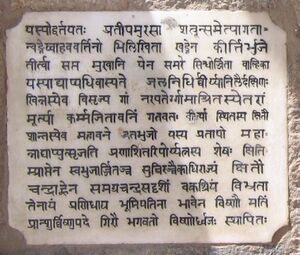
The iron pillar of Delhi, India is a 7 meter (22 feet) high pillar in the Qutb complex which is notable for the composition of the metals used in its construction.
The pillar, almost seven meters high and weighing more than six tons, was erected by Chandragupta II Vikramaditya (375 CE–414 CE), (interpretation based on analysis of archer type Gupta gold coins) of the Gupta dynasty that ruled northern India 320–540.[21] The pillar with the statue of Chakra at the top was originally located at a place called Vishnupadagiri (meaning “hill with footprint of Lord Vishnu”).[22]
This has been identified as modern Udayagiri, situated in the vicinity of Besnagar, Vidisha and Sanchi. These towns are located about 50 kilometres east of Bhopal, in central India. There are several aspects to the original site of the pillar at Udayagiri. Vishnupadagiri is located on the Tropic of Cancer and, therefore, was a centre of astronomical studies during the Gupta period. The Iron Pillar served as a sundial when it was originally at Vishnupadagiri. The early morning shadow of the Iron Pillar fell in the direction of the foot of Anantasayin Vishnu (in one of the panels at Udayagiri) only around the summer solstice (June 21). The Udayagiri site in general, and the Iron Pillar location in particular, are evidence for the astronomical knowledge that existed in Gupta India.
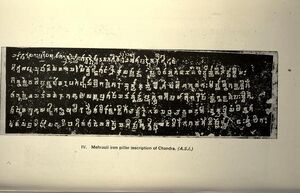
The pillar bears a Sanskrit inscription in Brahmi script which states that it was erected as a standard in honour of Lord Vishnu. It also praises the valor and qualities of a king referred to simply as Chandra, who has been identified with the Gupta King Chandragupta II Vikramaditya (375-413). The inscription reads (in the translation given in the tablets erected by Pandit Banke Rai in 1903):
- He, on whose arm fame was inscribed by the sword, when, in battle in the Vanga countries (Bengal), he kneaded (and turned) back with (his) breast the enemies who, uniting together, came against (him);-he, by whom, having crossed in warfare the seven mouths of the (river) Sindhu, the Vahlikas were conquered;-he, by the breezes of whose prowess the southern ocean is even still perfumed;-
- (Line 3.)-He, the remnant of the great zeal of whose energy, which utterly destroyed (his) enemies, like (the remnant of the great glowing heat) of a burned-out fire in a great forest, even now leaves not the earth; though he, the king, as if wearied, has quit this earth, and has gone to the other world, moving in (bodily) from to the land (of paradise) won by (the merit of his) actions, (but) remaining on (this) earth by (the memory of his) fame;- (L. 5.)-By him, the king,-who attained sole supreme sovereignty in the world, acquired by his own arm and (enjoyed) for a very long time; (and) who, having the name of Chandra, carried a beauty of countenance like (the beauty of) the full-moon,-having in faith fixed his mind upon (the god) Vishnu, this lofty standard of the divine Vishnu was set up on the hill (called) Vishnupada.
Jat History
Following Jat clans are found in Vidisha at present:
- Dhorelia,
- Israwa,
- Sirohi,
- Thenua,
- Khenwar
- Dusad
- Dondariya
- Chouhan
- Budhotiya
- Kasinwar
- Palwar
- Punchhwar
- Hanselia
- Tomer
- Agha
- Sangwan
- Chahar
- Bhagor
- Bhukar
Following villages found in Vidisha are associated with Jat clans:
- Nehra,Kurwai tahsil in Vidisha, Madhya Pradesh
- Poniya is Village in Gyaraspur Tahsil in Vidisha district in Madhya Pradesh.
- Kakapura - Ancient historical site in Vidisha district, Madhya Pradesh.
- Arki (अर्की) Aki (अकी)[23] are gotra of Jats. Aki clan found in Uttar Pradesh. [24] They get this name from place called Aran (आरान) fort. The residents of this fort were known as Arki. This fort was in possession of Varika (वारिक) King. [25] Aran village is in Gyaraspur tahsil in Vidisha district in Madhya Pradesh.
- Vangara (वंगारा) is Gotra of Jats found in Ratlam district in Madhya Pradesh. They are descendants of Nagavanshi king Vangara (वंगारा) (40-31 BC) of Vidisha in Madhya Pradesh prior to the end of Sunga dynasty at Vidisha. [26]
- Jatpura - Jat village is in Nateran tahsil of Vidisha district in Madhya Pradesh
- Bedan (बेदान) is a gotra of Jats. [27] [28] Bedan Khedi village is in Basoda Vidisha tahsil of Vidisha district Madhya Pradesh.
- Panawar village is in Kurwai tahsil in Vidisha district in Madhya Pradesh.
Notable persons
- वी.एस. चौहान, अध्यक्ष, जाट समाज, विदिशा/ से.नि.एसडीओ, कृषि
- लाखन सिंह जाट, सचिव,जाट समाज/सर्विस तथा ठेकेदार
- राज कुमार सिंह, कोषाध्यक्ष/रेलवे में सर्विस
- जसवंत सिंह सिरोही, एसडीओ,पीएचई,9893425234
- भुजबल सिंह राणा, कृषक
- ज्ञानसिंह जाट, कृषक
- एडवोकेट मोहनसिंह जाट,वकालत
- रामूराम जाट भूकर,राजस्थान स्वीट्स बिजनेस
- राजेंद्र सिंह जाट,टीचर 8770605145
- मूलचंद जाट,खेनवार कृषि
- मोहनसिंह जाट,9826426435
- लोकेन्द्रसिंह जाट, 9993538389
- पुष्पेन्द्र सिंह जाट
- Raghuvir Singh Jat - Retd. DSP [29] Mob:9826097094
- Ashok Jat - Parshad Vidisha Nagar Palika Vidisha (M P ).[30]
- Narendra Singh Dhorelia - Mahendra Tractor Agency, Vidisha, Mob:9425614899
- Laxmi Narayan Israwa - Vidisha, Mob:9826274316, 7869964036[31]
- Nilu Singh Jat (Thenua) - Vidisha, Mob:9826954082[32]
- Amit Jat (Dusad)- Cricket Player
- Atul Jat - Taekwondo Player (Vikram Award 2009)
- Jitendra Singh Chouhan, officer in cooperative bank. 9713919865
External links
Gallery
-
अशोक जाट
-
भुजबल सिंह राणा
-
ज्ञानसिंह जाट
-
जसवंत सिंह सिरोही
-
लाखन सिंह
-
राजकुमार सिंह जाट
-
रामूराम जाट
-
रणवीर सिंह जाट
-
वही एस चौहान
-
-
-
-
-
-
-
References
- ↑ Mahajan V.D. (1960, reprint 2007) Ancient India, New Delhi: S.Chand, ISBN 81-219-0887-6, pp.587-8
- ↑ K. D. Bajpai:The History of Gopāchala, p.24
- ↑ History and Historians in Ancient India, By Dilip Kumar Ganguly, p.28
- ↑ Nagas: the Ancient Rulers of India, p.334
- ↑ Jayaswal KP. P-15.
- ↑ Bajpai, ,K.D., Indian Numismatic Studies, New Delhi,1996,p.11
- ↑
- शतं दासी सहस्राणां कार्पासिक निवासिनाम
- शयामास तन्व्यॊ दीर्घकेश्यॊ हेमाभरण भूषिताःMahabharata (II.47.7)
- ↑ Sandhya Jain: Adi Deo Arya Devata - A Panoramic View of Tribal-Hindu Cultural Interface, Rupa & Co, 7/16, Ansari Road Daryaganj, New Delhi, 2004, Page 131
- ↑ Aitihasik Sthanavali by Vijayendra Kumar Mathur, p.645
- ↑ Aitihasik Sthanavali by Vijayendra Kumar Mathur, p.673
- ↑ भारतकोश-भिलसा
- ↑ Aitihasik Sthanavali by Vijayendra Kumar Mathur, p.855-857
- ↑ बाल्मीकि रामायण, उत्तर 108,10
- ↑ Aitihasik Sthanavali by Vijayendra Kumar Mathur, p.855
- ↑ Aitihasik Sthanavali by Vijayendra Kumar Mathur, p.857
- ↑ Aitihasik Sthanavali by Vijayendra Kumar Mathur, p.723
- ↑ तदा समुथ्राश चत्वारॊ नथी भागीरथी च या, कालिन्दी विदिशा वेण्णा नर्मदा वेगवाहिनी (II.9.18)
- ↑ विदिशां कृष्ण वेण्णां च ताम्रां च कपिलाम अपि, शलुं सुवामां वेदाश्वां हरिस्रावां महापगाम (VI.10.27)
- ↑ The Bhilsa topes: Inscriptions, P. 251
- ↑ See Plate XII. This Pillar has the Standard Bearer and Relic Bearer sculptured on its inward faces.
- ↑ Identity of Chandra and Vishnupadagiri of the Delhi Iron Pillar Inscription: Numismatic, Archaeological and Literary Evidence, R Balasubramaniam, Bulletin of Metals Museum, 32 (2000) 42–64.
- ↑ On the Astronomical Significance of the Delhi Iron Pillar, R Balasubramaniam and Meera I Dass, Current Science, volume 86 (2004) pp. 1134–1142.[1]
- ↑ Jat History Dalip Singh Ahlawat/Parishisht-I, s.n. 46अ-
- ↑ Jat History Thakur Deshraj/Chapter VIII,s.n. 6,p.585
- ↑ Mahendra Singh Arya et al: Adhunik Jat Itihas, p.220,s.n. 17
- ↑ Dr Naval Viyogi: Nagas – The Ancient Rulers of India, p.160
- ↑ Jat History Dalip Singh Ahlawat/Parishisht-I, s.n. ब-209
- ↑ O.S.Tugania:Jat Samuday ke Pramukh Adhar Bindu, p.53, s.n. 1817
- ↑ Purusharth, Jat Sabha Bhopal, Smarika 2009, p. 50
- ↑ Jat Samaj, January-February 2010, p. 52
- ↑ Jat Vaibhav Smarika Khategaon, 2010, p. 46
- ↑ Jat Vaibhav Smarika Khategaon, 2010, p. 93
- Santosh Kumar Thakur mob.no.9826546968
Back to Madhya Pradesh/Back to Inscriptions




